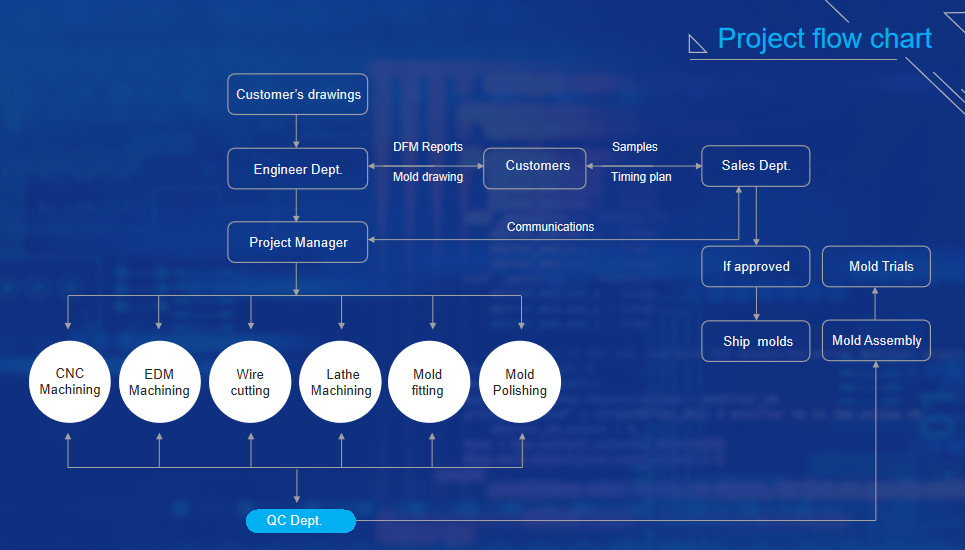Introducing the entire project process of mold making from order received to plastic injection molding parts or components delivered. We accomplish this by high efficient and scientific project management. We believe the high efficiency brought by letting the professional people handle the professional case, which is also the philosophy of our project management. Mold making is the process of designing and creating molds that serve as the blueprint for producing identical copies of a particular object or part.

We can provide an overview of the process involved in executing a plastic injection molding project:
Project Planning and Requirements Gathering:
This initial phase involves understanding the client’s requirements, including the desired plastic part specifications, quantities, quality standards, and budget constraints. It’s crucial to establish clear communication and expectations between the client and the injection molding manufacturer.
Design and Engineering:
Once the requirements are understood, the next step is the design and engineering phase. This involves designing the mold for the plastic part using computer-aided design (CAD) software. The mold design considers factors such as part geometry, material selection, mold complexity, and manufacturability. Collaboration between design engineers and mold makers ensures that the mold is optimized for the injection molding process.
Prototyping:
Before moving into full-scale production, it’s often beneficial to create prototypes of the plastic part. Prototyping allows for testing and validation of the design, ensuring that the final part meets the desired specifications and performance requirements. Rapid prototyping techniques such as 3D printing or CNC machining may be used to create prototypes quickly and cost-effectively.
Tooling and Mold Fabrication:
Once the design is finalized and prototyping is complete, the mold for the plastic part is fabricated. This involves CNC machining or other machining techniques to create the mold cavity and core according to the approved design. The mold may also undergo surface treatments such as polishing or texture application to achieve the desired finish on the molded parts.
Injection Molding Setup:
With the mold ready, it is installed onto an injection molding machine. The machine is configured with the appropriate injection parameters such as temperature, pressure, and injection speed based on the material being used and the part design. Test runs are performed to validate the molding process and optimize settings for production.
Production and Quality Control:
Once the setup is complete and parameters are optimized, full-scale production of the plastic parts begins. Throughout the production process, quality control measures are implemented to ensure that the molded parts meet the specified dimensional tolerances, surface finish requirements, and material properties. This may include in-process inspections, sampling, and testing of finished parts.
Post-Processing and Finishing:
After molding, the parts may undergo additional post-processing steps such as trimming, machining, surface treatment, or assembly, depending on the project requirements. These finishing operations are conducted to achieve the final desired form and functionality of the plastic parts.
Packaging and Delivery:
Once the plastic parts are finished and inspected, they are packaged according to the client’s specifications and prepared for shipment. Proper packaging ensures that the parts are protected during transit and arrive at their destination in optimal condition.
Feedback and Continuous Improvement:
After completing the project, feedback from the client and lessons learned during the process are evaluated to identify areas for improvement. This feedback loop helps refine future injection molding projects and ensures ongoing quality and efficiency in production.
By following these steps and maintaining effective communication and collaboration throughout the project lifecycle, plastic injection molding projects can be successfully executed to deliver high-quality, cost-effective plastic parts that meet the needs of clients and end-users.


